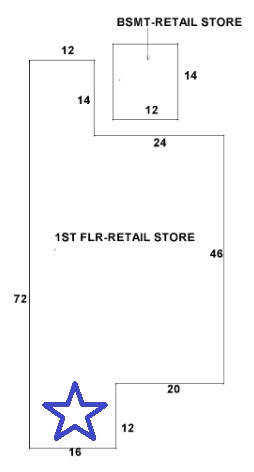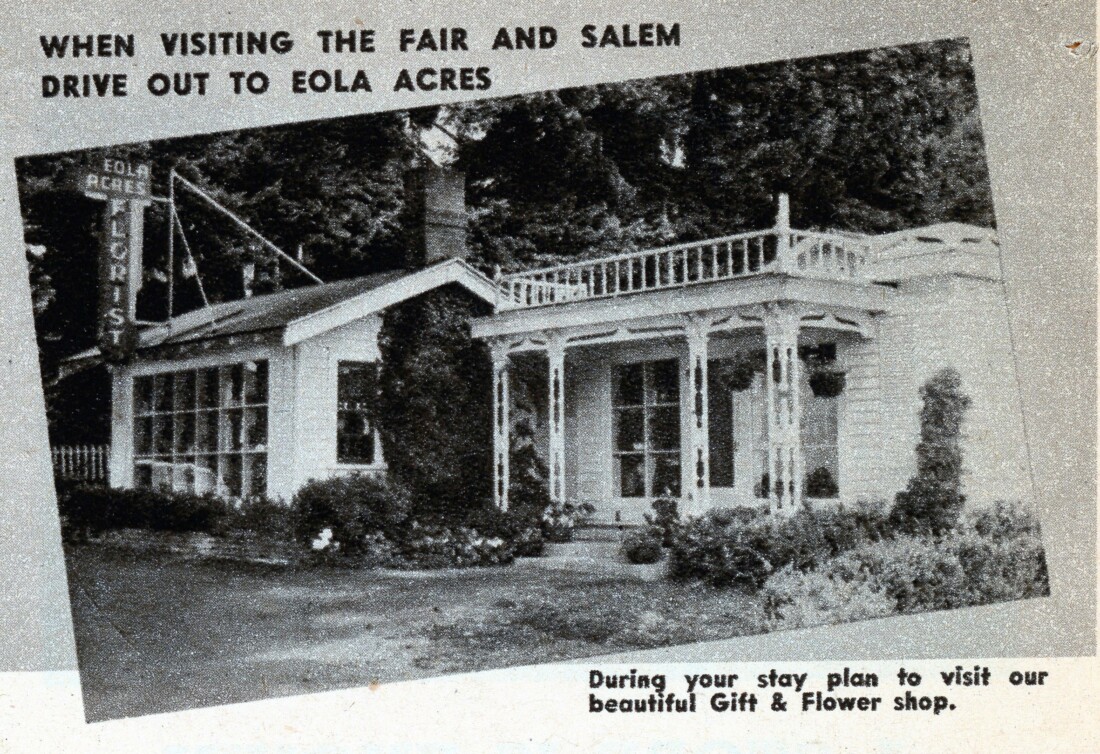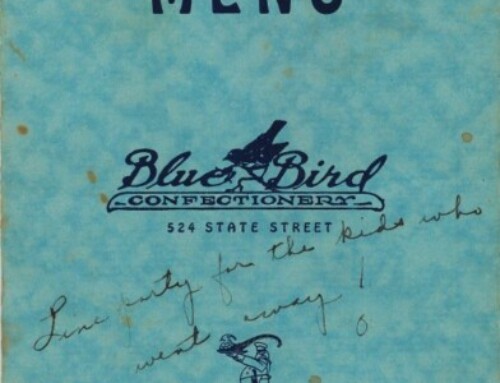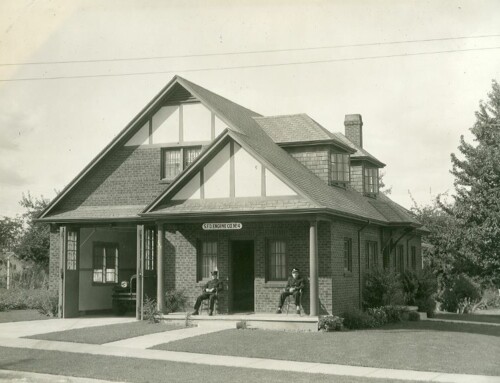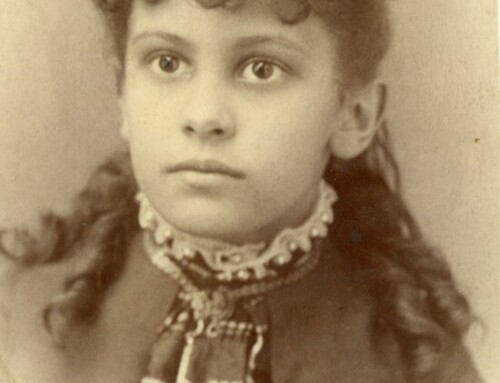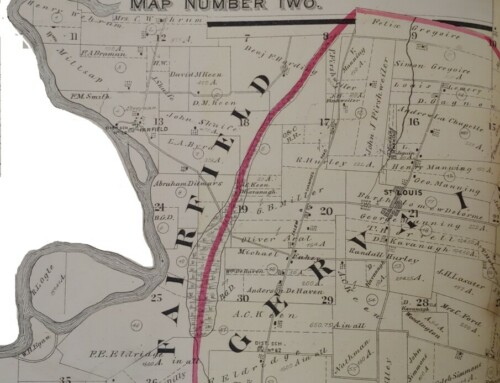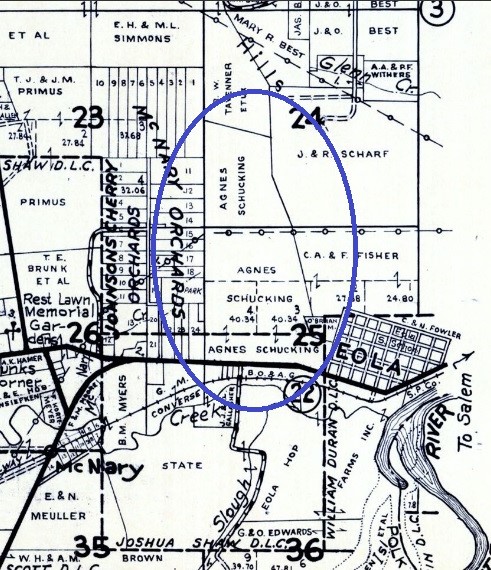
This Metsker map for Polk County dated 1962 shows the breadth and scope of the Eola Acres 144-acre farm formerly held by the Gilbert-Patterson families, then purchased by the Schucking family. Historic Map Works
Isaac Lee Patterson and Andrew Nathaniel Gilbert were business and agricultural partners in the late 19th century. They owned and ran the Gilbert and Patterson Grocery store in Salem[i] and maintained farm property across the Willamette River in rural Polk County to supply their own trade. As the men aged and pursued political interests, their business and agricultural holdings were assumed by the next generation which included Gilbert’s daughter and son-in-law, Agnes and Bernard Schucking. Bernard was a hop broker by trade, so it was a natural fit to assume managerial interest in the farm’s yearly crop. After the death of A.N. Gilbert, Agnes and Bernard continued to manage the property for his widow Estelle. Then in 1930, after the death of I.L. Patterson, the Schuckings purchased his half of the Gilbert-Patterson holdings from his widow.[ii] They remodeled the Patterson farmhouse and moved to the property fulltime with Agnes’ mother Estelle in the fall of 1930. In 1931, they purchased the Gilbert half from Agnes’ mother Estelle.[iii]
The gift shop originated as a roadside farm stand built by the Patterson family. In an anecdotal tale, Governor Isaac Patterson, a tall, white-haired man, sold peaches at the farm stand by the side of the road just past the town of Eola, proper.[iv] When the Schuckings moved to the property fulltime, they continued the practice, offering plants, cut flowers, fruits, and other agricultural products grown on the 144-acre farm, known as Eola Acres.
In late 1938, the Schuckings had a more permanent, winterized structure built and launched the Oak Tree Shop at Eola Acres just in time for the Christmas holiday shopping season. The shop was named for the stately oak tree that stood between the building and the highway, offering shade during warm summer months. The following ad appeared in the newspaper:
“New Oak Tree Shop is now open for business at Eola Acres. It is different. You will find gold and silvered leaves for center pieces, Christmas wreaths, greens, mistletoe, potted plants, apples and farm products.”[i]
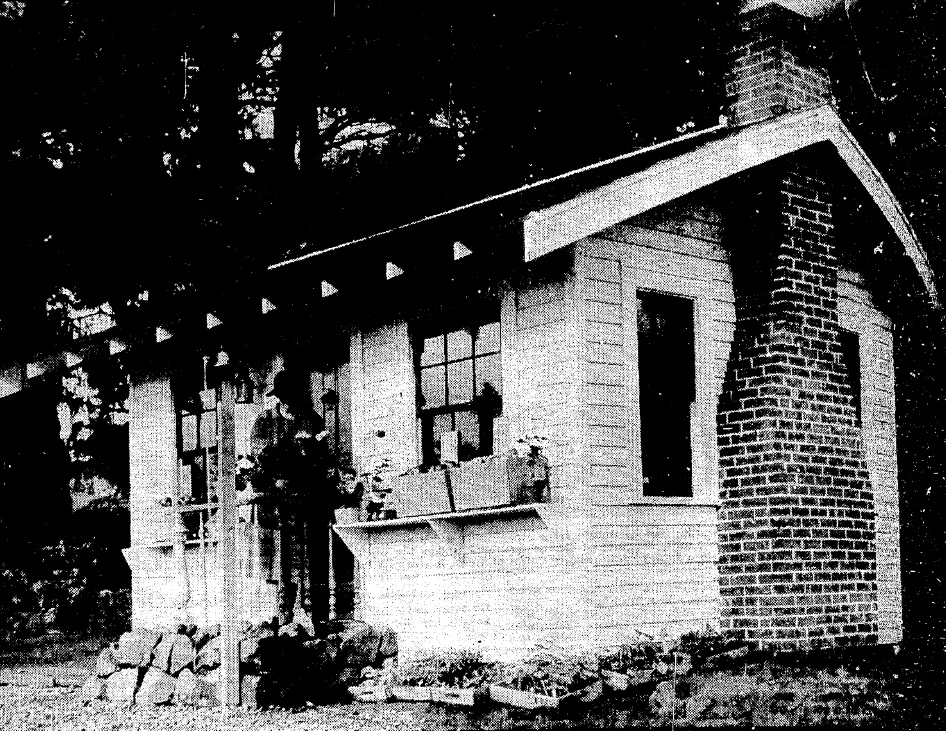
Agnes Schucking on the doorstep of her Oak Tree Shop as it appeared in the Oregonian, 22 January 1939, Newsbank.com
January 1939 brought an Oregonian reporter and friend Ben Maxwell out to the shop for an interview with Agnes Schucking.[ii] The article is reproduced here in its entirety, given the valuable information regarding the structure.
“Successful roadside selling is largely a matter of external appearances according to Mrs. B.O. Schucking, who recently built this neat, attractive highway market for farm products on the Dallas highway four miles west of Salem.
It was Mrs. Schucking’s idea that her highway market should neither be too large nor too small. A 16-foot frontage with a depth of 12 feet seemed about right for comfort and adequate display area. The ceiling is eight feet high.
For exterior construction, a good grade of six-inch drop fir siding was selected. Continuation of the roof forms a three-foot eave and provides ample protection for the neat stone porch.
Adjacent to the porch is an announcing bell reminiscent of the farm dinner bell of long ago. When the attendant is absent from the market the prospective customer pulls the bell rope and summons the attendant from the nearby home. A weathered ship’s lantern, modernized for electrical usage, provides porch illumination for night customers.
Exterior surfaces received ample paint coats of white, while the seven windows and two doors are trimmed in cherry red.
Plywood, oiled but not stained, was selected for interior walls. Door and window casings, however, carry a walnut stain that blends harmoniously with the linoleum floor covering.
Venetian blinds cover each window and add to the modernity of this modern rural market. In addition to natural light, the place is wired and plenty of outlets are in evidence as a measure of convenience.
The 30 by 30-inch fireplace, 18 inches deep, efficiently heats and ventilates the interior, besides contributing an admired charm. Inside shelves, cupboards and brackets have been installed for the suggestive but not aggressive display of farm produced fruits, eggs, vegetables, and plants. Such rural merchandise is naturally attractive to purchasers from the city as it is neatly displayed in this attractive, modern market.”
In 1940, Agnes received an award from the National Council for Outstanding Achievement in Roadside Improvement, for the “roadside store which does a successful business without benefit of posters, signs or other roadside advertising.”[iii]
Within a year of the shop’s opening, business had increased to the point where “hundreds of folks drive out to buy those things that are just a little different”, reported the Capital Journal. [iv]Agnes needed more room, so in 1940 the Schuckings built a larger retail store on the site which incorporated and updated the original structure. The larger space boasted 2016 square feet with a small basement of 168 feet in the back northwest corner.[v] With the new structure came a new name, Eola Acres Florist and Gift Shop.
Agnes also hired help. House maid Helene Schultz’ duties expanded to help with the farm and floral shop. Then in 1946, Agnes hired florist and designer Robert Owens from the Potter School of Design in Portland.[vi] From this point on the farm and gift shop’s success skyrocketed. After it was featured in a collection of colored motion pictures of Oregon commissioned by Senator Charles L. McNary and filmed by prominent Salem photographer Kathryn Gunnell,[vii] national garden and florist organizations began to recognize them with awards.[viii]
Ten years later it was time for another remodel, this time late in the year 1950. When construction delays threatened their Christmas business, Agnes opened the family home to host the shop’s Christmas displays. And a holiday tradition was born. The annual event came to be known as Holiday House and was held daily from Thanksgiving weekend through Christmas Eve each year, typically from noon to 8 p.m.[ix]
An article in the Christmas 1960 issue of Florists Telegraph Delivery News magazine described the tradition as follows.
“In a setting of early American décor and antique furniture the [Schucking] home becomes a wonderland of Christmas trees, yule decorations and ornaments, gifts, and arrangements of flowers and greens.”
“A hostess greets the visitors and makes them feel at home as they browse through the house. Coffee and Christmas cookies are served. Guests are given baskets to pick ornaments off the many decorated Christmas trees.
“Holiday House of the Christmas season at the Schucking home annually attracts about 3,000 persons.”
From Christmas open houses, floral parades, community events, and the bread and butter of weddings, funerals and other special occasions, the Eola Acres Florist and Gift Shop continued to operate through the years. Employees Bob Owens and Helene Schultz were adopted by Agnes in 1953 and continued to help run the business.[x] Then tragically in 1969, death claimed Agnes in October and son Bob a month later.[xi] The business and property passed to Helene.[xii] She ran it successfully until its final Holiday House and closure in December 1996.[xiii] Property records show that ownership was converted to a living trust in 1999.[xiv] Then in 2000 after the death of Helene, Eola Acres LLC was set up.[xv] The property remained under this holding until 2020 when it was purchased by J&M Rental Properties LLC.[xvi] It is currently under development.
[i] “New Oak Tree Shop” Capital Journal (Salem, OR) 16 Dec 1938 p. 11
[ii] “Stand attracts motorist trade; modernity keynote of design” Oregonian (Portland, OR) 22 Jan 1939 p. 88
[iii]“Oregon State Federation of Garden Clubs activities. Medal of merit awarded” Oregonian (Portland, OR) 10 Mar 1940
[iv] “Mrs. Schucking Not to Build Mouse Traps” Capital Journal (Salem, OR) 16 Dec 1939 p. 8
[v] Polk County Assessors website
[vi] “Florist Here” Oregon Statesman (Salem, OR) 19 July 1946 p. 5
[vii] “McNary to Show Pictures” Oregon Statesman (Salem, OR) 28 Mar 1940 p. 5
[viii] “Mrs. B.O. Schucking Wins Fine Honor” Capital Journal (Salem, OR) 28 Feb 1940 p. 5
[ix] “Holiday House Is Featured in Publication” Oregon Statesman (Salem, OR) 11 Oct 1960 p. 6
[x] Adoption Announcement, Oregon Statesman (Salem, OR) 21 Dec 1953 p. 6
[xi] Death Certificates, Oregon State Archives
[xii] Probate Records, Polk County Courthouse
[xiii] City Directories
[xiv] Polk County Assessors Records
[xv] Ibid
[xvi] Ibid
[i] Andrew Nathaniel Gilbert Biography, History of the Willamette Valley, OR, Robert Carlton Clark, Chicago, S.J. Clarke Publishing Co. 1927, Vol. 2, p. 406-408
[ii]Polk County Deed Records, Polk County Assessors website
[iii] Ibid
[iv] “Schuckings’ Buy I.L. Patterson Farm and Home at Eola” Capital Journal (Salem, OR) 15 Aug 1930 p. 1



